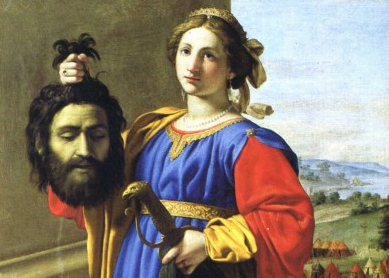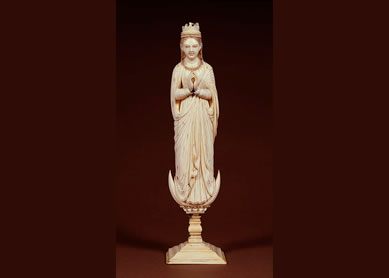Infamous seductress or paragon of virtue—which label describes Judith, the Jewish heroine who destroyed the Assyrian general Holofernes? Medieval Christian artists celebrated her as a symbol of pious widowhood, while modern Western artists depicted her as a bloodthirsty femme fatale. As a visual flashpoint for female sexuality, gender roles, and violence, Judith’s iconography reflects the cultural history of art.
From the eighth-century Church of Santa Maria Antiqua onward, Christian artists emphasized Judith’s piety and prayer, portraying her as defender of God’s people. Many depicted her as a proper Christian woman cast in the same mold as the Virgin Mary—veiled head and hair, body asexual and unadorned, rapt in prayer. Her bold (and to some eyes, masculine) actions that felled the enemy general Holofernes were left out of the picture; only the heavy sack in which she (or Abra, her maidservant) victoriously carried the general’s head back to Bethulia hints at her audacity.
Following the pattern of early Christian theologians, Rabanus’s ninth-century commentary on the book of Judith built up her image as a Marian prototype, concurrent with the rise of Mariology. Medieval epics expanded her role to that of chaste female warrior as artists saw a visual parallel between Judith cutting off Holofernes’s head and the medieval motif of Mary trampling the head of the serpent (an allusion to
Renaissance artists like Donatello transformed Judith from the defender of Bethulia to the feminine personification of democracy and the city, with David as her male counterpart. These political and civic dimensions paralleled the Florentine struggle for independence from the tyranny of the Medici. The painters Giorgione and Veronese exposed more of her body, beginning her transformation from medieval pious widow into an icon of sexualized femininity.
On the eve of the Reformation, the Northern European fascination with the power of women whose sexuality and violence matched that of men led artists, especially Lucas Cranach the Elder, to depict Judith’s female nature and violent act as sexually aggressive.
The distinctive Bibles of the Reformation and Counter-Reformation—vernacular translations, including Luther’s Bible in German with a reorganized Old Testament devoid of apocrypha, contrasted with the 16th-century edition of the Latin Vulgate with apocrypha—redefined and reimaged Judith. Absent from the Hebrew Bible, Judith and “her book” had no formal place in Lutheran and Reformed theology but fulfilled an ambiguous cultural role as a female worthy or seductress.
From the 17th century on, northern European artists characterized Judith as a nude woman who took pleasure in the gore and violence of her female sexuality. Southern artists, like Caravaggio and Artemisia Gentileschi, however, represented her in the midst of severing Holofernes’s head as a sign of the Church triumphing over the heresy of the Reformers.
With the secularization of the modern world, Judith, like other biblical women, was transformed by artists and writers from her initial visual role as a Marian prototype into an object of the male gaze. She became confused with other literary and mythological head hunters, most especially Salome. From the late 19th century, Judith and Salome garnered the attention of artists like Klimt and later Von Stuck, who highlighted the mystique of the femme fatale and the fascination with female sexuality and violence. Previously demure, Judith stood newly alone, fully nude, and proudly triumphant holding her prize—Holofernes’s head.



